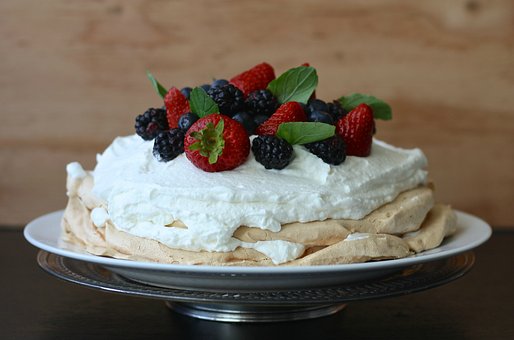 When I was in Finland this past summer, I ended up at a party hosted by a group of people from New Zealand. The dessert they provided goes by the unlikely name of Pavlova.
When I was in Finland this past summer, I ended up at a party hosted by a group of people from New Zealand. The dessert they provided goes by the unlikely name of Pavlova.The pavlova is a dessert consisting of a base made up of a baked sweetened meringue, topped with fruit and whipped creme.
I remember trying to make the dessert when I was a teenager living in Australia. It was hard to bake it just right because if the oven was too hot, it overcooked, too low, it under cooked and if someone stomped, it died.
It requires egg whites, sugar, corn starch, and a bit of vinegar whipped into a stiff meringue that is placed on a piece of parchment paper in a circle. It is then baked for 1.5 hours at around 250 degrees. The trick is to leave it in the oven when the time is done and let it cool completely before opening the oven door. This is the part that makes it a difficult dessert to make.
According to what I understand, this beautiful dessert was created to celebrate the visit of world famous Russian ballerina Anna Pavlova who visited both Australia and New Zealand in 1920. Both countries have claimed its creation but it appears recipes for it were published in New Zealand Cookbooks and magazines before the same recipes appeared in Australia.
Either way, the dessert is extremely sweet, extremely delicious and extremely addicting.
The second is the Baked Alaska which as far as I know is not a regular dessert served in the state of Alaska. Baked Alaska is ice cream encased in either pastry or meringue. There is a record from 1802 showing Thomas Jefferson served ice cream wrapped in pastry for dessert at a state dinner in the White House.
Researchers have found a recipe called Baked Alaska Apple pie dating from 1855 in which the author has cooks add ice cream to the apple pie before placing the top crust on it and baking it. Between then and 1900, there are records of a variety of desserts similar to the dish we call Baked Alaska but none carried that name until the Fannie Farmer Cookbook of 1896.
She has the cook prepare a meringue which is put over a cake topped by ice cream before browning it under the grate. Originally it used a walnut spice cake for the base, topped with banana ice cream, and covered all over by the meringue. The reality is that no one is absolutely sure who created the dessert and who named it.
The final dessert is the ever popular trifle, a layered dessert with cake, fruit, pudding, and whipped cream. Early versions of this dessert resembled fools, a dessert of pureed fruit mixed with creme. The two names were often used interchangeably to refer to the same dessert. In fact, trifle developed as a way to use up old cake.
There are records from the mid 1700's show that alcohol, cookies or cake, and custard was combined to create trifles served in a special trifle bowl. These bowls were prized possessions of many a housewife. By 1751, recipes started appearing in various cookbooks.
Although most trifles now a days are nonalcoholic, alcohol in the form of sherry, Madeira or brandy were the chosen flavors traditionally used in this dessert. Over time, arguments have arisen over the type of jelly, whether the custard should be made from scratch or from a powder, etc.
The only trifle I've ever eaten was made by a family aunt who used lady fingers, vanilla pudding, fruit, and whipped cream on top of it all. I've never had the alcoholic version nor have I ever eaten the traditional English version.
Let me know what you think. Have a good day.
It is said the name was inspired by the purchase of Alaska in 1867.
No comments:
Post a Comment